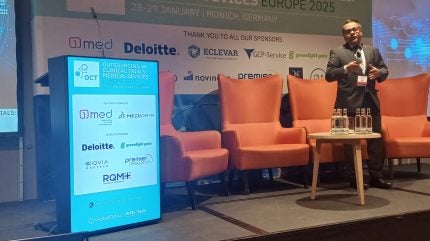
Shifting patient demographics and the rise of AI-based technology and wearables are emerging as key drivers of innovation in the healthcare space.
Speaking at the Outsourcing Clinical Trials (OCT) Medical Devices 2025 conference, taking place in Munich, Germany, on 28-29 January, Pradipto Kolay, R&D leader, concept development/innovation, X-ray at Philips, said ageing patient populations and technology are affecting the broader healthcare industry on how healthcare is delivered.
One of the broader implications of ageing is the effect it has on healthcare costs.
Kolay stated that one school of thought says ageing is causing an “explosion of cost”, while another asserts that 90% of spending on healthcare happens in the last year of life; therefore, the expenditure is merely postponed rather than increasing.
A more pronounced impact of ageing is the kind of disease profiles that are associated with it, Kolay continued, pointing by way of example to the rising incidence of Alzheimer’s and age-related macular degeneration (AMD).
“This is happening because people are living longer, so a new set of diseases and a new set of patterns are evolving, which we didn’t see, or at least saw less of, in the past.”

US Tariffs are shifting - will you react or anticipate?
Don’t let policy changes catch you off guard. Stay proactive with real-time data and expert analysis.
By GlobalDataDuring the presentation on innovation trends, Kolay also highlighted the huge progress made in terms of cardiovascular disease within the last decade and that the mortality burden of cardiovascular disease today has significantly lowered, but that ageing was having an effect on this as well.
Kolay said: “This basically means that people are living longer and there are newer diseases. The distribution is different.”
According to Kolay, reduced cardiovascular mortality burden and the focus on cardiovascular health now moving towards conditions such as diabetes and obesity that are attributable to lifestyle factors are also resulting in clinical shifts.
“This gives a unique opportunity for the industry to focus more on rare and orphan diseases, which it couldn’t do before,” he added.
The tech factor
Acknowledging that cost-saving measures are an inevitable driver of innovation, Kolay notes there is now a move towards a preference for preventative care, with efforts being made towards factors, including reducing hospital stays and moving towards more home-based care.
Innovation in this sense, however, is also being enabled by a range of technological advances to shift the nature of healthcare delivery, with technological advances such as the rise of personalised medicine modalities such as telemedicine facilitating more home-based care.
Kolay explained: “For personalised treatment and precision medicine, one needs to be able to continuously monitor diseases.”
To meet these changes in healthcare delivery, Kolay believes that a lot more data and new study designs are needed.
He said: “The other part is, of course, an increase in behavioural and observational studies.
“A rise in the understanding of behaviour in patient-doctor interactions is going to play an important role here.”



